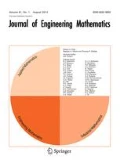Summary
A simple new series, using an expansion of the velocity profile in parabolic cylinder functions, has been developed to describe the nonlinear evolution of a steady, laminar, incompressible wake from a given arbitrary initial profile. The first term in this series is itself found to provide a very satisfactory prediction of the decay of the maximum velocity defect in the wake behind a flat plate or aft of the recirculation zone behind a symmetric blunt body. A detailed analysis, including higher order terms, has been made of the flat plate wake with a Blasius profile at the trailing edge. The same method yields, as a special case, complete results for the development of linearized wakes with arbitrary initial profile under the influence of arbitrary pressure gradients. Finally, for purposes of comparison, a simple approximate solution is obtained using momentum integral methods, and found to predict satisfactorily the decay of the maximum velocity defect.
Similar content being viewed by others
References
H. Schlichting,Boundary Layer Theory, McGraw-Hill Book Co., Inc., 1962.
S. Goldstein, Concerning Some Solutions of the Boundary Layer Equations in Hydrodynamics,Proc. of Camb. Phil. Soc., 26, pp. 1–30, 1930.
S. Goldstein, On the Two-dimensional Steady Flow of a Viscous Fluid Behind a Solid Body,Proc. Roy. Soc. London, A 142, 545, 1933.
K. Stewartson, On Asymptotic Expansions in the Theory of Boundary Layers,J. Math. Phys. 36, pp. 173–191, 1957.
A. F. Charwat and J. Der, Studies on Laminar and Turbulent Free Shear Layers with a Finite Initial Boundary Layer at Separation,Proceedings of Conference of Separated Flows, Part I, AGARD C.P. 4, 1966.
A. F. Charwat and L. Schneider, Effect of the Boundary Layer Profile at Separation on the Evolution of the Wake,AIAA J., 5, 6, 1967.
H. Bateman,Higher Transcendental Functions, vol. II, McGraw-Hill Book Co, 1953.
S. H. Hollingdale, Stability and Configuration of the wake produced by Solid Bodies Moving Through Fluids,Philosophical Mag. 7, 29, 1940.
G. Srinivasan, An Experimental Investigation of Turbulent Wakes Behind Two-Dimensional Bodies,M.E. Project Rep. Dept. of Aero. Engg., I.I.Sc., Bangalore, 1966.
A. Prabhu, Incompressible Wake Flow in Pressure Gradient,AIAA J., 4, pp. 925–926, 1966.
H. Gold, Laminar Wake With Arbitrary Initial Profiles,AIAA J., May 1964.
P. G. Hill, “Turbulent Wakes in Pressure Gradients”,M.I.T., Gas Turbine Lab. Rep. 65, 1961.
P. G. Hill, Turbulent Jets in Ducted Streams,J.F.M., 22, 1, pp. 161–186, 1965.
S. Vasantha, Evaluation of Some Integrals Arising in the Solution for the Wake Development from an Arbitrary Initial Profile,Rep 69 FM4, Dept. of Aeronautical Engg. I.I.Sc. 1969.
Author information
Authors and Affiliations
Rights and permissions
About this article
Cite this article
Vasantha, S., Narasimha, R. A nonlinear theory of wake development. J Eng Math 4, 51–63 (1970). https://doi.org/10.1007/BF01535179
Received:
Issue Date:
DOI: https://doi.org/10.1007/BF01535179



